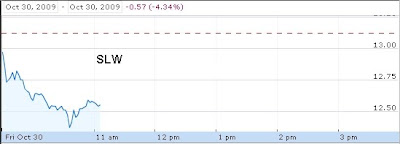
Salar de Atacama: World's Largest Reserve of Lithium
Sociedad Quimica Minera of Chile trades as ADR SQM on the NYSE. The company has the largest reserves of Lithium in the world. It has lots of it, and with very high grade. In fact, it has supply for hundreds of years even considering the best optimistic scenarios for electric car production.
Here are a few charts from their analyst update in January 2009.
Lithium demand:

Lithium sources and concentration:

Salar de Atacama Details:

Lithium supply:

SQM chart:

(please click to enlarge)
SQM's RSI values are 48.05 (daily), 56.67 (weekly), 69.7 (monthly). The monthy is too high for comfort.
------
On the lithium bubble:
The theory, which has seen shares in lithium stocks double and triple over the past few months, is that cars such as the Chevrolet Volt and the Nissan Leaf will trigger a massive increase in the demand for lithium-ion batteries.
Says DryBlower, a mining site:
"Leight Clifford, a Rio Tinto hero long before Stern Hu snatched that claim to fame, once famously said he wasn’t interested in “mining the periodic table”. That might be one reason why Rio Tinto’s name is not associated with the latest speculative boom to grip stock markets around the world – lithium. Another reason is that lithium might easily turn out to be a member of a passing parade of metals that have their 15 minutes of glory, before exiting stage right never to be heard of again. Classic signs of irrational exuberance about an ultra-light metal which might have a bright future in the electric car industry.
Right now, and time is important for red-hot lithium stocks, it appears that lithium-ion is the battery of choice for car makers because it is light and stores a lot of electricity.
The second belief driving the lithium boom is that the world doesn’t have much of the stuff and a shortage of supply will push the price through the roof.
Dear, oh dear! Where were these children trading in lithium shares when we had a gallium boom because it was the metal for computer chips, hafnium for nuclear fuel rods, or scandium for aluminium alloys and golf clubs? Dryblower has been around long enough to remember each of these booms, plus a few more such as scheelite in the 1950s, and vanadium (every 10 years).
The point about this trip down memory lane is not merely to demonstrate that there are a lot of elements on the periodic table, but that every one of them has a use somewhere, sometime.
The real issue is that very few, apart from the commonly traded metals such as copper, nickel and zinc, have a depth of market sufficient to justify a mine development, or that there is actually a shortage of supply (or booming demand) to ensure high prices for the life of a mine.
Gallium is a Dryblower favourite. Back in the 1980s (or perhaps it was the 70s), the big French chemical company, Rhone Poulenc, bowled into Australia and announced a joint venture with Alcoa to extract the gallium from the liquor circuit streaming through the Pinjarra alumina refinery.
The Frogs spent $50 million on their gallium plant. Operated it for a few months, and then closed it. Why? Because the world market for gallium arsenide dried up, and better (and cheaper) metals came along for computer chips.
This is the big issue confronting lithium today. No one, not even Dryblower can say that lithium does not have a future as a metal for the electronics industry, or for the potential boom in electric cars. But, there are issues to consider, and they include: How much lithium does the world want? How much is currently produced, where and by whom? What is the world’s recoverable lithium resource? The last time these questions were asked they applied to magnesium, which was also a metal set to revolutionise the world’s vehicle industry – but didn’t.
Hundreds of millions of dollars was tipped into magnesium production, until investors woke to the fact that the world used about two ship loads a year, and car makers wouldn’t switch until supply increased, and miners wouldn’t boost output until demand increased.
If Joseph Heller hadn’t written Catch 22 about the logic (or lack of it) about the bureaucratic world as seen in the US Air Force then the magnesium conundrum would make a perfect novel about lunacy.
Is lithium going to be a repeat? Well, the numbers aren’t too encouraging. According to local lithium leaders such as Galaxy Resources, the world currently uses 110,000 tonnes of lithium a year, likely to rise to 300,000t in 10 years.
Salar de Atacama, a single salt flat in Chile, is estimated to contain a resource of between 7.5 million and 35.7 million tonnes of lithium. Described as “the Saudi Arabia of lithium”, that lower number of 7.5Mt represents 68 years of supply at today’s rate of consumption, and 25 years at the forecast rate of demand in 10 years time. At the upper resource estimate Salar de Atacama contains 324 years of current demand and 119 years of forecast demand in 10 years.
Dryblower suspects the point is made because Salar de Atacama is just one source of supply, production can be easily increased, and alternative sources developed.
Perhaps Galaxy, with a project located in politically stable Australia, will be one of the new suppliers – this is why its share price has risen by 400% over the past year to a 12-month high of $A1.50 last week – and perhaps it will not".
Watch BNN
video.

































































